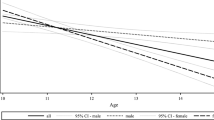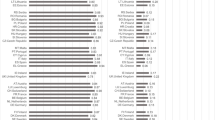Abstract
Many studies have estimated the effect of circumstances on income acquisition. Perhaps surprisingly, the fraction of inequality attributable to circumstances is usually quite small—in the advanced democracies, approximately 20%. One reason for this is the lack of data on circumstance variables in empirical research. Here, we argue that all behaviors and accomplishments of children should be considered the consequence of circumstances: that is, an individual should not be considered to be responsible for her choices before an age of consent is reached. Using two data sets that contain data on childhood accomplishments, other environmental circumstances and the income as an adult, we calculate that the fraction of income inequality due to circumstances in the US rises from 27 to 43% when accounting for childhood circumstances. In the UK it rises from 18 to 27%.






Similar content being viewed by others
Notes
See also the recent ‘The Equality of Opportunity Project’ for the US: http://www.equality-of-opportunity.org/.
Notably, the share of inequality explained by circumstances appears to be higher in developing as opposed to industrialized countries (see Brunori et al. 2013). Furthermore, relative measures of IOp are higher for consumption expenditures than for income measures. Yet as discussed by Ferreira and Gignoux (2011) this difference is attributable to the larger transitory component of the latter measure of economic advantage.
Richard Arneson writes that one can simplify the true process of the development of responsibility in a person by thinking of a canonical moment at which children become responsible for their choices. The “canonical moment” simplifying abstraction of the equal opportunity principle is motivated by the thought that there is a non-arbitrary and morally significant line between childhood and adulthood and that children are not morally responsible for their preferences in the way that adults are deemed to be (Arneson 1990).
Note that these baseline estimates would increase further when allowing for heterogeneous effects of circumstances on income. See Hufe and Peichl (2015) for a discussion.
Note that this methodology is reminiscent of the inequality decomposition suggested by Cowell and Jenkins (1995). However, their decomposition does not strictly rely on the division between circumstances and effort.
The same question has been studied by Elbers et al. (2008). Their solution, however, does not generalize to continuous distributions.
See Assaad et al. (2015) for an example calculation using Egyptian data.
Recall that the sample is not representative for the entire US population in the respective year, but nationally representative for the subpopulation of children born to mothers aged 14–21 on December 31, 1978. See Appendix Table 4 for a change in summary statistics when restricting the sample to the age range 25-30 and applying the respective sample weights.
Specifically, we use the following set of NLSY79 (BCS70) circumstances: sex, country of birth, ethnic identity, cohort, academic achievement mother, occupation code mother, rural/urban, height, family income, play w/ parents, perceived quantity of time w/ mother, parents split, smoking habits mother, drinking habits mother, school absence due to health, age mother at birth, standardized math and reading assessment.
See Appendix Table 6 in which we decompose the differences between the NLSY-specific and the comparable results into changes due to variable exclusions/inclusions and the respective sample size adjustments.
Comparing the central bar of Fig. 2 with our baseline estimate, we hold the number of circumstances constant while varying the permissible age of consent. To the contrary, when comparing the rightmost bar of Fig. 2 with our baseline estimate, we hold the age of consent constant, while varying the number of circumstances.
The reason is that the data provides only few respondents whose circumstance information is available both at age 12 and at age 16. When accounting for circumstances measured at both ages the sample is almost cut in half (Table 2). Therefore, we only consider circumstances measured at age 16 in our baseline estimations.
Generally, we find lower income inequality (in terms of the MLD) in net income when compared to gross income. At the same time, the level of IOp is higher in gross income. However, IOp as a percentage of total inequality is higher in net income. One interpretation of these findings is that the tax and transfer system in the UK is equalizing in terms of income inequalities rather than opportunities.
See footnote 10 for the precise set of circumstances.
References
Alesina A, Giuliano P (2011) Preferences for redistribution. In: Benhabib J, Jackson MO, Bisin A (eds) Handbook of social economics. North-Holland, Amsterdam, pp 93–132
Arneson R (1990) Liberalism, distributive subjectivism, and equal opportunity for welfare. Philos Public Affair 19(2):158–194
Assaad R, Krafft C, Roemer JE (2015) Inequality of opportunity for income and consumption in Egypt. Mimeo, New York
Björklund A, Jäntti M (1997) Intergenerational income mobility in Sweden compared to the United States. Am Econ Rev 87(5):1009–1018
Bourguignon F, Ferreira FHG, Menéndez M (2007) Inequality of opportunity in Brazil. Rev Income Wealth 53(4):585–618
Brunori P, Ferreira FHG, Peragine V (2013) Inequality of opportunity, income inequality, and economic mobility: some international comparisons. In: Paus E (ed) Getting development right: structural transformation, inclusion, and sustainability in the post-crisis Era. Palgrave Macmillan US, New York, pp 8–115
Cappelen AW, Hole AD, Sørensen EØ, Tungodden B (2007) The pluralism of fairness ideals: an experimental approach. Am Econ Rev 97(3):818–827
Cappelen AW, Sørensen EØ, Tungodden B (2010) Responsibility for what? Fairness and individual responsibility. Eur Econ Rev 54(3):429–441
Checchi D, Peragine V, Serlenga L (2010) Fair and unfair income inequalities in Europe. IZA Discussion Paper, No. 5025
Checchi D, Peragine V (2010) Inequality of opportunity in Italy. J Econ Inequal 8(4):429–450
Chetty R, Hendren N, Kline P, Saez E (2014) Where is the land of opportunity? The geography of intergenerational mobility in the United States. Quart J Econ 129:1553–1623
Cowell FA, Jenkins SP (1995) How much inequality can we explain? A methodology and an application to the United States. Econ J 105(429):421–430
Elbers C, Lanjouw P, Mistiaen J, Özler B (2008) Reinterpreting between-group inequality. J Econ Inequal 6(3):231–245
Ferreira FHG, Gignoux J (2011) The measurement of inequality of opportunity: theory and an application to Latin America. Rev Income Wealth 57(4):622–657
Ferreira FHG, Peragine V (2016) Individual responsibility and equality of opportunity. In: Adler MD, Fleurbaey M (eds) Oxford handbook of well-being and public policy. Oxford University Press, Oxford, pp 746–784
Fleurbaey M, Peragine V (2013) Ex ante versus ex post equality of opportunity. Economica 80(317):118–130
Fong C (2001) Social preferences, self-interest, and the demand for redistribution. J Public Econ 82(2):225–246
Hufe P, Peichl A (2015) Lower Bounds and the Linearity Assumption in Parametric Estimations of Inequality of Opportunity. IZA Discussion Paper, No. 9605
Kanbur R, Wagstaff A (2016) How useful is inequality of opportunity as a policy construct? In: Basu K, Stiglitz JE (eds) Inequality and growth: patterns and policy: volume I: concepts and analysis. Palgrave Macmillan, London, pp 131–150
Mostafa T, Wiggins D (2014) Handling attrition and non-response in the 1970 British Cohort Study. CLS Working Paper 2014/2
Niehues J, Peichl A (2014) Upper bounds of inequality of opportunity: theory and evidence for Germany and the US. Soc Choice Welf 43(1):73–99
OECD (2010) OECD Factbook 2010: Economic, environmental and social statistics. OECD Publishing, Paris
Pistolesi N (2009) Inequality of opportunity in the land of opportunities, 1968–2001. J Econ Inequal 7(4):411–433
Ramos X, Van de gaer D (2016) Empirical approaches to inequality of opportunity: principles, measures, and evidence. J Econ Surv 30(5):855–883
Rawls J (1971) A theory of justice. The Belknap Press of Harvard University Press, Cambridge
Roemer JE (1993) A pragmatic theory of responsibility for the egalitarian planner. Philos Public Aff 22(2):146–166
Roemer JE (1998) Equality of opportunity. Harvard University Press, Cambridge
Roemer JE (2017) On the importance of circumstances in explaining income inequality. Rev Econ 68(1):35–56
Roemer JE, Trannoy A (2016) Equality of opportunity: theory and measurement. J Econ Lit 54(4):1288–1332
Author information
Authors and Affiliations
Corresponding author
Additional information
We are grateful to the Russell Sage Foundation for support. We would like to thank Francisco Ferreira, Dirk Van de gaer as well as the participants in seminars in Mannheim and workshops in London and at Duke University for their helpful comments and suggestions.
Appendices
Appendices
1.1 Figures for net income (BCS70)
IOp across Time (BCS70), Net Income. The spike yields the extent of outcome inequality IO. The gray bar yields inequality attributed to circumstances, i.e. the lower-bound absolute measure of IOp. The number in each bar is the measure of r, the fraction of inequality due to circumstances. All circumstances are measured either at birth or age 16 with no circumstance repeatedly measured at different age thresholds
IOp with Different Ages of Consent (BCS70), Net Income. The spike yields the extent of outcome inequality IO. The gray bar yields inequality attributed to circumstances, i.e. the lower bound absolute measure of IOp. The number in each bar is the measure of r, the fraction of inequality due to circumstances. In the first bar only circumstances measured at birth are included. The second bar includes circumstances measured at birth and additionally those measured at age 10. The third bar additionally includes all circumstances measured at age 16
IOp and Ability (BCS70), Net Income. The spike yields the extent of outcome inequality IO. The gray bar yields inequality attributed to circumstances, i.e. the lower-bound absolute measure of IOp. The number in each bar is the measure of r, the fraction of inequality due to circumstances. All circumstances are measured either at birth or age 16 with no circumstance repeatedly measured at different age thresholds
Rights and permissions
About this article
Cite this article
Hufe, P., Peichl, A., Roemer, J. et al. Inequality of income acquisition: the role of childhood circumstances. Soc Choice Welf 49, 499–544 (2017). https://doi.org/10.1007/s00355-017-1044-x
Received:
Accepted:
Published:
Issue Date:
DOI: https://doi.org/10.1007/s00355-017-1044-x







